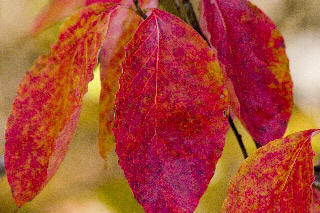 |
Photographing Fall ColorDigital Photography Article and Photos by Greg Disch
Many of you photographers like myself probably anticipate the coming of fall as one of those great times for photography. We have months to prepare for the fall color spectacular that we know is coming and only possibly a few days to shoot it. This article will help you to make the most of what time you do have to capture the fall color.
Why do leaves change color?
|
|||||||||||
Weeks of bright sunny days (not over 80) and chilly nights with no frost create the brightest colors. |
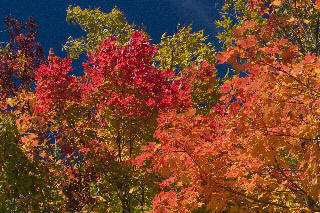 When will the color peak be?
When will the color peak be?
Predicting exactly when the peak of color is going to happen is one of the great mysteries of nature, many sources can give you an approximate timeframe for an area based on historical averages. Of course we all want to know when the peak will happen so that we can arrange time off, travel to a great location and reserve lodging (because for some reason it becomes difficult to find rooms in many locations this time of year). Ok, here's the answer, "it will peak after it starts and before it ends" and you can quote me on this. Seriously, my point is that there are many great times to shoot the fall colors, some trees will have lost all their leaves and be bare sticks by the time others are just stating to turn. To catch all the color you need to be out shooting for more than just a quick day or two, there are great shots all through the fall season.
Common fall tree colors: |
|
| Yellow | Ash, Basswood, Birch, Beech, Butternut, Elm, Hickory,
Mountain Ash, Poplar, Redbud, Serviceberry, Willow, some Maples. |
| Red | some Oaks and Maples, Sumac, Tupelos |
| Orange | some Oaks and Maples |
| Red or Yellow | Sugar Maple, Dogwood, Sweet Gum, Black Gum, Sourwood |
How to capture the best shots.
Concentrate on composition, don't assume all that beautiful fall color is going to make a great shot without consideration for composition, and having a clearly defined subject in the photo. Use all of the tools of composition: rule of thirds, leading lines, focus, highlights, shadows, s-cures, framing, vanishing point, and many others. Don't think that just because you have brilliant blazing color it will translate into a great photo. Move around shoot from every conceivable angle and position, use a variety of lenses, from wide angle to ultra telephoto. Take your time and visualize the image that you want in your mind, then make your camera give you that image. Check for distracting backgrounds and out of place items (no one wants to hang a beautiful photo of fall leaves, with an old beer can in the background, on their living room wall).
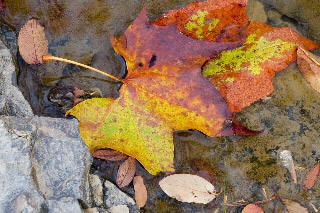 Move in Close.
Move in Close.
This is a great time to use that Macro or Close-up lens. Examine the fine details in single leaf. Look for natural still-life on the ground where leaves have haphazardly fallen to their resting place. Often as photographers we want to capture everything all in one frame. While there are fantastic fall landscape photos, too often we overlook the details and the smaller subjects of fall. A single leaf, bunch of berries or mushroom pushing up through the fallen leaves, can all make fantastic fall color shots. Use a large aperture to blur the background and focus on your main subject.
Filters
Now that we are shooting digitally, the role of filters is changed greatly from the days of shooting film. Most of the filter effects can be applied in post processing with a greater degree of control than we could ever hope to obtain by using filters when shooting. There are however some exceptions to this. One of the most important accessories you can have is a polarizing filter. It will remove glare and reflections, enhance and deepen colors and give you deep blue skies. A polarizing filter must be adjusted for each shot, because the effect is changed by the angle to the sun or light source, and is most effective at a 90 degree angle to the sun. The great thing is that you can look through the viewfinder and turn the filter seeing exactly what it is doing.
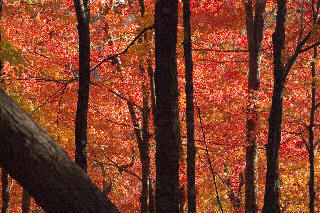 The
second exception (this could be done in Photoshop, but would take a lot
of work) is an Enhancing Filter. The Enhancing Filter makes reds, rust
browns and oranges "POP" with minimal effect on other colors.
The "ENHANCING
Filter" is a combination of rare earth elements in glass. It completely
removes a portion of the spectrum in the orange region. The effect is
to increase the color saturation intensity of certain brown, orange, and
reddish objects by eliminating the muddy tones and maximizing the
crimson and scarlet components. Its most frequent use is for obtaining
strongly saturated fall foliage. The effect is minimal on objects of
other colors.
The
second exception (this could be done in Photoshop, but would take a lot
of work) is an Enhancing Filter. The Enhancing Filter makes reds, rust
browns and oranges "POP" with minimal effect on other colors.
The "ENHANCING
Filter" is a combination of rare earth elements in glass. It completely
removes a portion of the spectrum in the orange region. The effect is
to increase the color saturation intensity of certain brown, orange, and
reddish objects by eliminating the muddy tones and maximizing the
crimson and scarlet components. Its most frequent use is for obtaining
strongly saturated fall foliage. The effect is minimal on objects of
other colors.
Lighting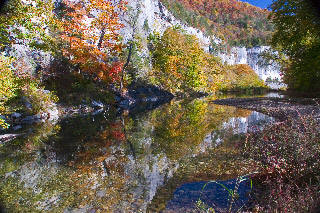
Good photos require good lighting. To many landscape photographers the lighting is the most important part of the photo, even more so than the subject. How do you get that great light when shooting outdoors? First thing is to know what makes good lighting and the second is to be there. A beautiful sunny day with clear blue sky, a great day for a drive in the country and taking great fall color photos. Well half right, a great day for a drive in the country, a bad day for photos. The light will be very high contrast, which means the areas where the sun is shining is too bright and the shadows are too dark. We can see about 11 "stops" of light with our eyes, our cameras will only see about 5 "stops". This is the type of lighting that we want to avoid, this does not mean you have to go home, just avoid this type of lighting. Find an area in full shade, move in close and shoot those macro shots.
Golden Hour or Magic Hour, this is one half hour after the sun rises and one half hour before the sun sets. This is the time of day that most great landscape photos are taken. There are several scientific explanations of why the lighting is so good for photography during this time, but I'm not going into that detail. Just believe me that this is a great time to shoot your landscape fall color photos.
Overcast days will provide better color saturation than a sunny day and a softer diffused light. This is great for capturing the color in fall leaves. Rain or mist can also really bring out the color in fall foliage just be sure to protect your camera and yourself and watch out for lightning. Another factor of photographing during or after a rain, is that the leaves are clean and free of dust which will hide the true color. The drawback of a full overcast day is that you can have a bright white sky, if this is the case the best thing to do, is to try and keep the sky out of the picture.
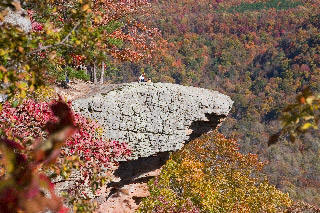
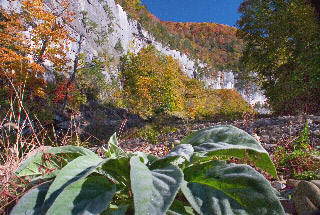
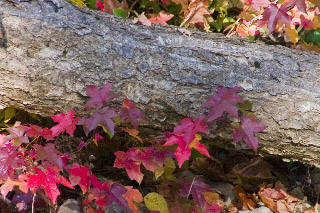
More information
The websites listed here will provide more information for the upcoming fall color season, including what areas are peaking, the first site is maintained by the US Department of Agriculture Forest Service and will start posting reports on Sept. 1st. The second site is by the state of Arkansas and will start posing on Sept. 27th.
http://www.fs.fed.us/news/fallcolors/
http://www.arkansas.com/calendar/fall_foliage_pg1.asp
